Les, a good friend of mine who I had recently helped with a rear axle swap, found that he had some pulsing in the brake pedal when he applied the brakes. We took a look at the recently installed rear drums and bled them, just in case. No help….the pulsing was still there. A week later, we found ourselves on the trail with another local Jeeper who also just happens to be everyone’s front end alignment guy (at least those who can appreciate a Jeeper doing front end alignments on lifted vehicles). We got to talking about the brakes and he mentioned that he had noticed that a front rotor on Les’ TJ was looking a bit warped when he last aligned it, just a couple of weeks ago.. Les came over to borrow my jack stands, the floor jack, and some advice so I took some picture of his TJ while he wrenched on it.
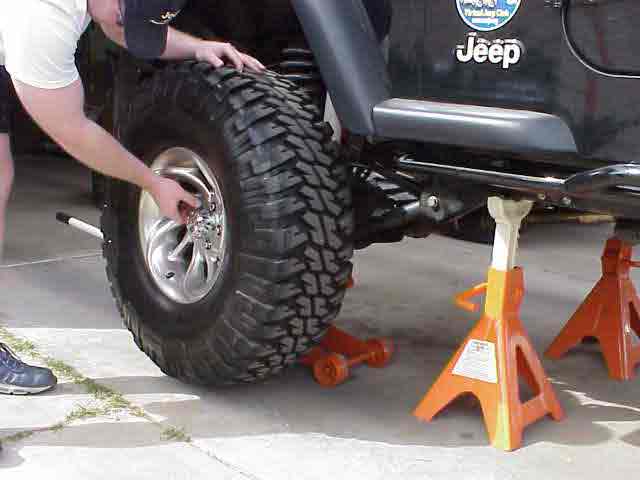
Be sure to safely support your vehicle when you are doing work near or under the vehicle while the tries are removed. I keep a pair of 12 ton jack stands (yeah, they are a bit of overkill) for this job and they do very well. They easily support a lifted TJ’s frame with room to spare. Because of their higher weight rating, they also provide a much better footprint than the smaller 4 or 6 ton jack stands. I like the increased stability they offer even though they cost a few bucks more. They are well worth it, in my opinion.
We raised the side of the TJ with the floor jack (and a block of wood) and then slipped the jack stand under the frame. This was repeated on the other side and we now had the vehicle supported for the brake job. With the floor jack providing a bit of support, Les removed both front tires.
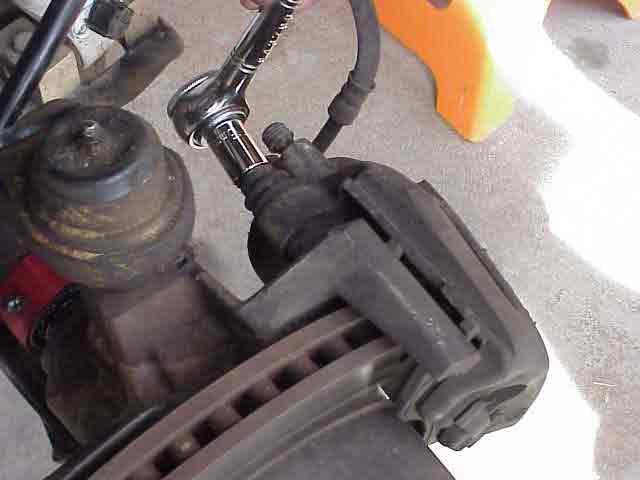
With the tire removed, remove the two caliper mounting bolts, as shown in the above picture. These bolts hold the caliper in place while allowing it to move back and forth so it can center itself on the rotor during braking. If memory serves me, it takes a 13mm socket. This should be the only wrench you should need for this project.
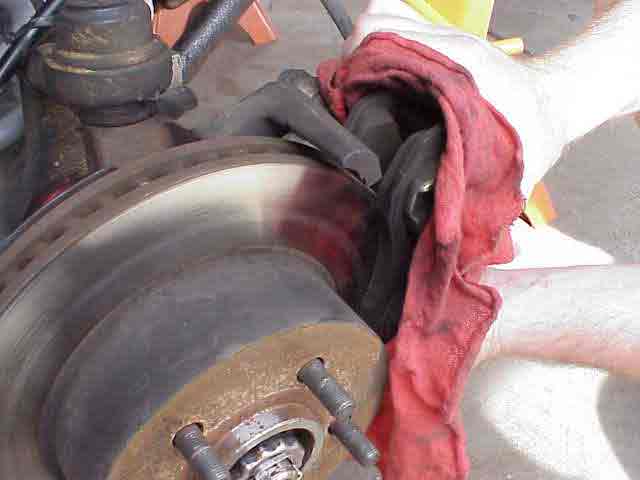
Before you remove the caliper, take a minute and look at how it sits on the mounting brackets. When you assemble the caliper, after installing the new pads, you will want it to look the same way. Now, with the two caliper mounting bolts removed, grab the top of caliper and pull it back and away from the rotor. The bottom of the caliper will pivot a bit on the mounting bracket as the caliper pulls away from the rotor. At this point, the brake dust is rather “all over” the place so I always suggest using a rag to help keep things a bit cleaner. You’ll have a chance to use some brake cleaner in a bit.
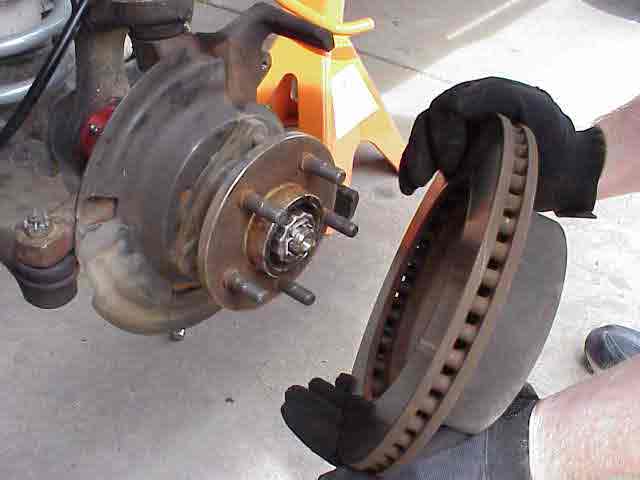
With the caliper out of the way, the rotor should slip off of the hub. Of course….this does not always happen, as Les discovered while taking the other rotor off. That one was stubborn to say the least (now I know how those Jeepers that live in the rust belt must feel when ever they have to remove something from their Jeep). The rotor was held in place with some rust between the hub and the rotor. We tried some PB Blaster, letting it sit for a while in hopes that it would break down the rust. I grabbed a 3 pound hammer and gently tapped around the center area of the rotor. No luck. We used some more PB Blaster and got a bit more aggressive with the hammer. Still no luck. We tried tapping from the back of the rotor (I don’t advise doing it this way) but still had no luck. Out came the propane torch. We went through a few cycles of heating the rotor (not the hub) and tapping with the hammer. It finally let go!
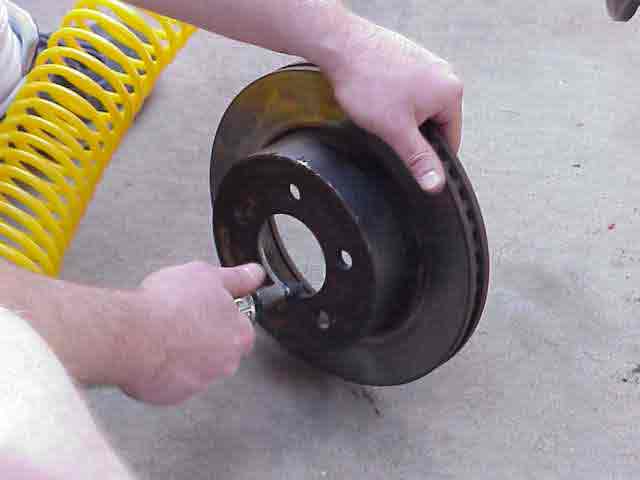
We decided it was a good idea to clean up the rusted surfaces with a die grinder. Les used a small wheel to get rid of the rust on both the rotor and the hub. He finished it off with some emery paper, making sure both of the surfaces were relatively clean from rust. Be sure to wear safety glasses or goggles when using power tools. Those little grinding stones and wire brushes will not respect your eyes!
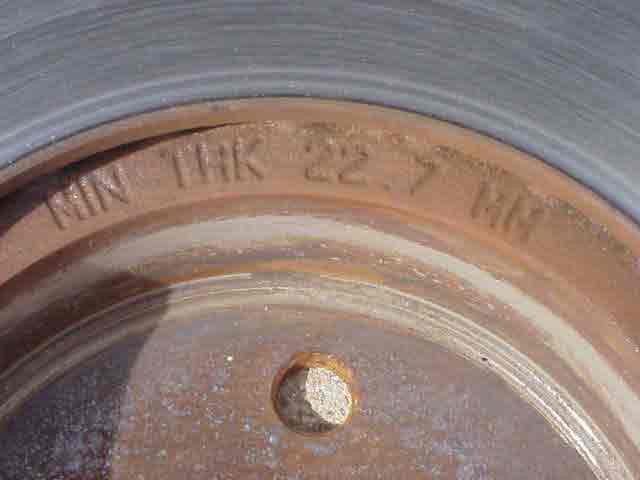
Brake rotors can be “turned” on a machine that will clean up the existing surface. To do this, a small portion of the rotor is actually machined away. If you have extremely deep gouges in the rotor’s surface, such as what occurs from running the pad’s backing plate (ie., metal on metal) on the rotor, you may not be able to have such a rotor turned. Les’ rotors had no such problems and from what we believed, they were just a bit warped. As can be see above, there is a minimum thickness spec stamped into the rotor and this measurement must be met once the machining is finished. If the rotor thickness does not meet the minimum specification, the rotor can not be used (and a new one must be purchased). The cost of turning the rotors was $12 and was done at the local Checker Auto store.
NOTE: Around 2001 or there about (I don’t think anyone knows the exact date), Chrysler changed the dimensions of the rotor and the unit bearing. In doing so, auto parts stores sometimes don’t realize that there are two different rotors (they list a single part number) or they have the part numbers listed for wrong year(s). It is also possible that your TJ got some of the last “old style” rotors but your friend, with the same year TJ as yours, has different ones (depending on when it was assembled).
So the point is that the thickness of the rotor hat, that part that slips over your wheel studs, is different between the two rotor styles. The difference is about 1/8″ and can be easily detected with a ruler. Lay the rotor on a flat surface with the hat up. Put a ruler down through the large hole in the middle of the rotor and note the measurement. Take the ruler (or the rotor if you wish) with you to the auto parts store when you get your new rotors and make certain the new ones share that same measurement. If they are wrong, they will still mount on your vehicle just fine….but when you slip your tire onto the studs and tighten the lug nuts, it will bind and you will NOT be able to rotate your tire.
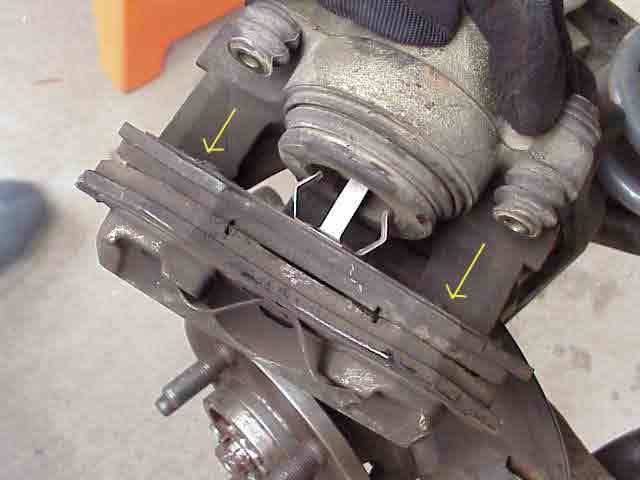
Since Les was replacing the pads at the same time, we needed to remove them from the caliper. The pad that snaps into the piston (of the caliper) is removed by pushing it in the directions of the yellow arrows, as seen in the above picture. You can see the metal clips that are attached to the pads backing plate. These clips hold it securely in place. Just push hard on the back of the pad and it will pop out as shown above.
Although Les was replacing his pads with Performance Friction pads which greatly improves the braking performance (I installed them on my TJ when I did my rear disc conversion), his existing pads still had sufficient material to allow for continued use. In the above picture, you can see two grooves cut into each of the two pads. These are wear indicators. When you can no longer see the grooves, your pad material is just about gone and you should replace them with new pads. I don’t remember if there is a core charge on the backing plates or not so just to be safe, take your old pads with you when you go to the auto parts store, just in case.
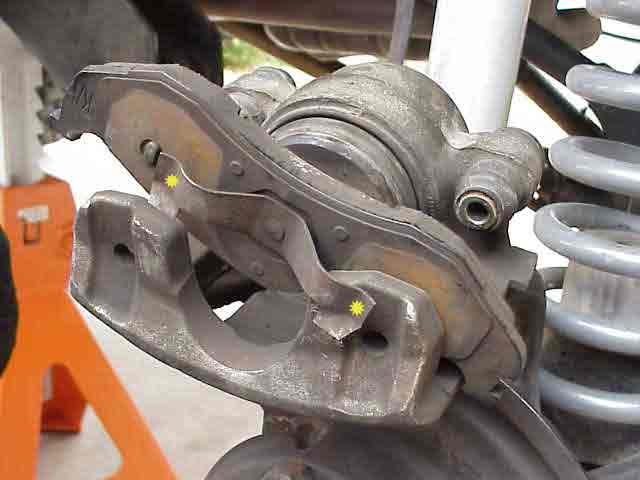
The other pad is removed by prying the clips out of their grooves with something like a screwdriver. The pad in the pic above is just about out of the caliper. I put little yellow dots on the picture to denote the tabs that must be carefully pried out of their slots. This backing plate also has a couple of small round pins on the back of it which center the pad in place on the caliper housing.
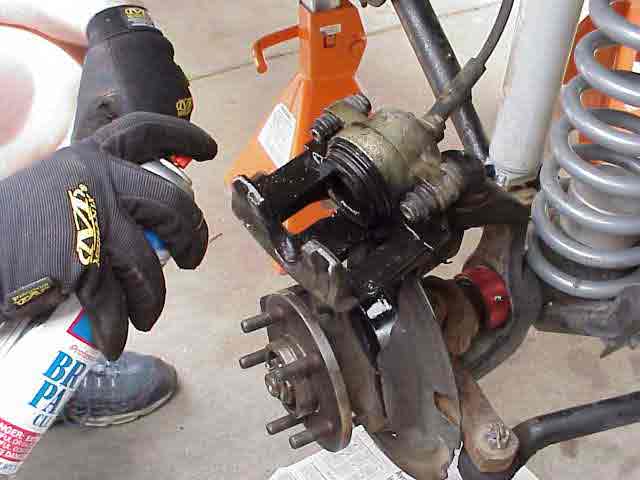
With the pads removed, Les uses a can of brake cleaner to remove the dust and such from the caliper. Spread a couple of newspapers (or a catch container) under the area to catch all of the junk that drips off.
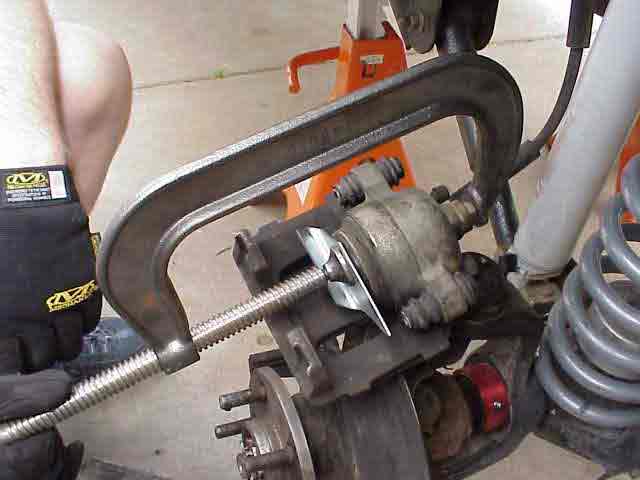
Since the rotor and pads have worn down over time, the piston will be sticking out of the caliper housing a bit too far. If left this way, you would not be able to put the caliper back onto the rotor once the new pads were installed. An easy way to correct this problem is with the help of a c-clamp. Place a piece of scrap metal (or thin wood) on the front of the piston (where the pad goes) and VERY carefully tighten the c-clamp to push the piston back into the caliper housing.
If you have ABS brakes, follow the information in Note 1.
If your TJ has non-ABS brakes, you can still follow the procedure in Note 1 or you can follow the old style method outlined in Note 2, the difference being you won’t be opening your bleeder screw for the old method. If it has been a while since you ran some fresh brake fluid through your lines, now would be a good time to do so….following the information in Note 1 and you will be able to flush out the old fluid as you bleed the brake lines.
NOTE 1: It is extremely important to open the bleeder screw when compressing caliper pistons or wheel cylinders during brake maintenance. When a caliper piston is pushed in, brake fluid gets forced backward, up into the system. Since the caliper is the lowest point in the system, dirt and corrosion naturally accumulate there. When this grime and dirt finds its way into the HCU portion of the ABS system, it can cause valves to stick. This can lead to: a vehicle pulling one way or another; accumulators sticking open, which leads to low pedal; compensator ports plugging, which leads to dragging brakes; and of course, it can make the ABS light come on due to all of the above. When you have finished pushing the piston back into the caliper, close the bleeder screw. You will need to bleed the brake lines later on.
NOTE 2: When a caliper piston is pushed in, you will be moving brake fluid back into the brake reservoir. Depending on how much you compress each caliper, and depending on how full the reservoir actually is, you can easily overflow the reservoir. Now would be a good time to open the hood and check your reservoir. You may have to remove some of the brake fluid (I always keep an old turkey baster in the garage for these kind of jobs) so as to prevent it from running all over the place. Remember, brake fluid and paint do NOT play well together. You do NOT want to get it on your Jeep’s paint.
As this point, it is time to reverse the process and put everything back together. Les retrieved his rotors from the Checker Auto store and found that there was plenty of rotor left (ie., no problem meeting the minimum thickness specification). He also picked up his Performance Friction pads from AutoZone (about $38) and so was ready to go.
One last thing….I almost forgot. Don’t forget to lubricate the caliper mounting bolts with some brake lubricant (no, this is not a joke). It is a special lubricant that comes in little 1/4 ounce tubes. Sometimes they include it with the brake pads. If not, spend a dollar and pick some up. It is much thinner than the regular grease you use on your suspension components. Spread the lube along the length of the mounting bolts. This allows the caliper to easily slide back and forth on the mounting bolt (wihch it is suppose to be able to do in order to compensate for pad and rotor wear).
The mounting bolts are NOT to be torqued too tight. My factory service manual states 11 ft. lbs. (Yes…that is NOT very tight at all). If you cranked them down too far, you will strip the threads out in the mounting bracket, as others have unfortunately discovered. Also….don’t replace these bolts with just any old bolt. The length is critical…..too short, they won’t hold the caliper in place….too long, they will protrude through the mounting bracket and cut into the rotor.
If you followed the information in Note 1 (above), you need to bleed your brakes. It is an easy process so grab a friend and you’ll be done shortly.
If you installed a new pair of Performance Friction pads, you will need to break them in. This consists of a series (about 10) of rapid braking stops from about 40 MPH down to a full stop. After the first round of ten, drive around and let the rotors cool down a bit. After 5 minutes or so of no or low braking effort, repeat the rapid stopping sequence another 10 times. During this entire process, you should notice the braking performance improves as the Performance Friction pads are broken in. After the second set of 10 stops, you are done. As I said earlier, I highly recommend these pads to anyone that is running a lifted vehicle with bigger tires. Les noticed the improvement right off. Best $40 mod you can make, in my opinion.
That is about it. With everything back together and the pads broken in, all you have to do now is enjoy those new brakes!
